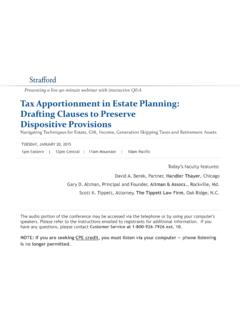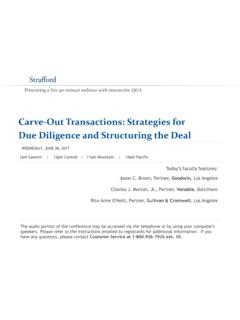Transcription of Mandatory Combined Reporting for State Income Taxes
1 Presenting a live 110 minute teleconference with interactive Q&AMandatory Combined Reporting for State Income Taxesfor State Income TaxesImproving Tax Compliance to Manage Conf licting State Rules1pm Eastern | 12pm Central | 11am Mountain | 10am PacificTHURSDAY, AUGUST 4, 2011 Today s faculty features:1pm Eastern | 12pm Central | 11am Mountain | 10am PacificSylvia Dion Owner State and Local Tax Consulting Westford MassSylvia Dion, Owner, State and Local Tax Consulting, Westford, Bareham, Tax Manager, SC&H Group, Sparks, Stevens, Partner, Parker Poe, Columbia, Pretty, Partner, Parker Poe, Charlotte, this program, attendees mustlisten to the audio over the Pretty, Partner, Parker Poe, Charlotte, refer to the instructions emailed to the registrant for the dial-in can still view the presentation slides online. If you have any questions, pleasecontactCustomer Service at1-800-926-7926 ext.
2 MaterialsIf you have not printed the conference materials for this program, please complete the following steps: Click on the + sign next to Conference Materials in the middle of the left-hand column on your screen hand column on your screen. Click on the tab labeled Handouts that appears, and there you will see a PDF of the slides for today's program. Double click on the PDF and a separate page will open. Double click on the PDF and a separate page will open. Print the slides by clicking on the printer Education CreditsFOR LIVE EVENT ONLYA ttendees must listen to the audio over the telephone. Attendees can still view the presentation slides online but there is no online audio for this must stay on the line for at least 100 minutesin order to qualify for a full 2 credits of CPE. Attendance is monitored as required by NASBA. Please refer to the instructions emailed to the registrant for additional information.
3 If you have any questions, please contact Customer Service at 1-800-926-7926 ext. 18009267926 ext. for Optimal QualitySd QlitSound QualityFor this program, you must listen via the telephone by dialing 1-866-873-1442 and entering your PIN when prompted. There will be no sound over the web ect o .If you dialed in and have any difficulties during the call, press *0 for assistance. Yo u m a y a l s o send us a chator e-mail so we can address the QualityTo maximize your screen, press the F11 key on your keyboard. To exit full screen, press the F11 key againpress the F11 key Cbid Rti f Mandatory Combined Reporting for State Income Taxes SeminarAug. 4, 2011 Beverly Bareham, SC&H F. Dion, State and Local Tax Pretty, Parker Stevens, Parker Poe d ay s ProgramBackground To This Trend[Sylvia F. Dion]Slide 7 Slide 11 Differences In Mandatory , Elective Combined Reporting [Sylvia F. Dion]Recent Developments With Combined ReportingSlide 12 Slide 17 Slide 18 Slide 78[Sylvia F.]
4 Dion, Beverly Bareham, Ray Stevens, George Pretty]Recent Developments With Forced Combinations[Ray Stevens and George Pretty]Slide 79 Slide 91[Ray Stevens and George Pretty] states Information-Gathering Efforts[Beverly Bareham]Ft Otl kSlide 92-Slide 96 Slid 97 Slid 99 Future Outlook[Beverly Bareham, Ray Stevens, George Pretty]Slide 97-Slide 99 BACKGROUND TO THIS Sylvia F. Dion, State and Local Tax ConsultingBACKGROUND TO THIS TRENDC ombined Reporting OverviewpgGeneral Concepts Combined Reporting : A methodology for apportioning the business Income of a corporate taxpayer that is a member of a commonly controlled group. A name given to a series of calculations by which a unitary business apportions its Income on a geographic basis. its Income on a geographic basis. Combined unitary Reporting principle and formulary apportionment have existed for more than 100 years. I i i ll li d h d l i f ild i Initially applied as methodology to apportion property Taxes of railroad companies that operated in various states Based on the idea that a company s multi- State business activities should be treated as a single entity, as opposed to separate activities occurring in numerous statesgy,pppg Apportionment concept applied to State corporate Income taxation in Mobil Oil Corp.
5 V. Commissioner of Taxes , 445 425 (1980), in which the Supreme Court declared the unitary principle to be the linchpin of apportionability in the field of State ta ation field of State taxation 8 Combined Reporting OverviewpgContrast To Federal Consolidation Despite resemblance to the federal consolidated return concept (followed by some states that allow consolidated filing), Mandatory Combined Reporting differs in a number of significant respects. Apportionment methodology vs. type of return:Federal consolidation involves the filing of a single return for a group of affiliated corporations, with the consolidated group s tax computed as if the group were a single economic entity. In contrast, Combined unitary Reporting is not a type of economic entity. In contrast, Combined unitary Reporting is not a type of return but rather the name given to the calculation by which a unitary business group apportions its Income .
6 80% vs. 50% ownership:Federal consolidation requires an 80%-or-greater .p:qgownership threshold (followed by certain states that allow State consolidated filing). Most states that permit or require inclusion in a Combined unitary report use a lower, 50% ownership Reporting OverviewpgContrast To Federal Consolidation (Cont.) Comparison of federal consolidated return concept to Mandatory Combined Reporting (Cont.) Unitary business requirement: Federal consolidated group members are notrequired to be engaged in unitary business operations (this is also the case in states that permit consolidated filing). In contrast, members subject to State unitary combination (because the State s ownership threshold has been exceeded) must generally also be engaged in a unitary threshold has been exceeded) must generally also be engaged in a unitary relationship with other Combined group members. Inclusion of foreign affiliates: The taxable Income of foreign country affiliates are not included in a federal consolidated return (this is (generally also the case in states that permit consolidated filing).
7 Depending on the State s rules, some Mandatory Combined Reporting states require or permit the inclusion of foreign country affiliates in a Combined nitar report if s ch affiliates meet the o nership threshold Combined unitary report, if such affiliates meet the ownership threshold and unitary business Reporting OverviewpgUnitary Business Concept Unitary business concept: Has evolved largely through court decisions and legal interpretation over the years Three-unities test (Butler Bros. v. McColgan, 315 501 (1942)): Unity or ownership, operation and use Contribution or dependency test (Edison Cal. Stores, Inc. v. McColgan, 176 697 (Cal. 1947)): An enterprise s in- State business operations contribute or depend on an enterprise s out-of- State business operations. Flow-of-value test (Container Corp. of America v. Franchise Tax Board, 463 159 (1983)): Some sharing or exchange of value .. bd h fl f f d i i f i i beyond the mere flow of funds arising out of a passive investment Factors-of-profitability test (Allied-Signal, Inc.)
8 V. Division of Taxation, 504 768 (1992)): Looks to functional integration, centralization of t d i f lmanagement and economies of scale11 DIFFERENCES IN Sylvia F. Dion, State and Local Tax ConsultingDIFFERENCES IN Mandatory , ELECTIVE Combined REPORTINGC ombined Reporting OverviewpgComparison Of Group Reporting Methods State corporate filing options for controlled group members vary among the states . Mandatory separate-company return states that follow a Mandatory separate company return approach do not permit or require consolidated returns or Combined unitary reports. Each member of a commonly controlled group, even those in a unitary relationship with each other, must file as a separate economic entity ( , Delaware, Maryland, Pennsylvania). Electivestate consolidated return In these states , commonly controlled members may file a separate company return OR may electto file a State consolidated return if company return OR may electto file a State consolidated return if the State s requirements for a consolidated filing are met.
9 13 Combined Reporting OverviewpgComparison Of Group Reporting Methods (Cont.) Electivestate consolidated return (Cont.) About 20 states fall into this category, including Alabama, Florida, Iowa and South Carolina. In some elective states , related corporations compute taxable Income on separate basis, and the aggregate collective liability is reported on a single return. Oth t t f ll th f dl lid ti th d Other states follow the federal consolidation method. Greater-than-50% or -80% ownership requirement, depending on State All filers must have nexus in the State (often referred to as a nexus lid ti h)consolidation approach). Some states prohibit members with special apportionment formulas from joining in a State consolidated return. M b jiig i tt lidti t t i d t b i Members joining in a State consolidation return are not required to be in a unitary relationship with other consolidated return group Reporting OverviewpgComparison Of Group Reporting Methods (Cont.
10 State Mandatory Combined Reporting : Not a group tax return per se but rather a methodology for apportioning the business Income of a corporation that is a member of a commonly controlled group of corporations engaged in a unitary business Generally based on a 50% ownership requirement Generally requires the presence of a unitary relationship between group members (some exceptions, , unitary relationship not required where a Combined group based on a Massachusetts affiliated group election) The total business Income subject to apportionment may include the business Income of unitary affiliates without nexus to the State . If the State s requirements for combination are met, filing on a unitary Combined basis is Mandatory , not elective. Foreign affiliates may be included in a Mandatory Combined filing Foreign affiliates may be included in a Mandatory Combined filing. As of 2011, approximately 24 states mandate unitary Combined Reporting .










